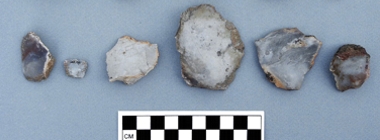The Puzzle of Translucent Silex
We visited Neolithic settlement sites in and near the Petrota graben and examined samples of the flaked stone found on their surface. Vrahos silex was present in every site but it was not always the material of choice. Some of the samples were dominated by a distinctive semi-translucent, variously colored material, to which we refer as “translucent silex.” This translucent silex is extremely rare in the scatter on the Vrahos hill, where it occurs in small chunks, usually up 50 g. Since the translucent silex on the Neolithic sites occurs in pieces that exceed by far that range, it seems unlikely that Vrahos can be the chief source. We think we found the source of the translucent silex five kilometers East of Vrahos, in the hills near the village of Komaros. Here, in an area of several hectares, the ground is littered with coarse gravel, including cortical cobbles of this silex (Fig. 22). Partly decorticated cobbles, waste flakes, and even a few roughly shaped cores can also be seen on the surface (Fig. 23). The preference for translucent silex among (some of) the Neolithic inhabitants of the region raises intriguing questions. The material is next to intractable. In the Neolithic sites the ratio of used products to waste is very low, and much of the waste appears to be the result of smashing rather than controlled flaking. In short, a relatively large volume of translucent silex was carried onto the Neolithic sites, but very little of it in the end was useful for making tools. A strictly utilitarian explanation seems inadequate. Perhaps the pattern is related to the functioning of the region’s social networks. If so, a special value might have been attached to this material (Fig. 24).


